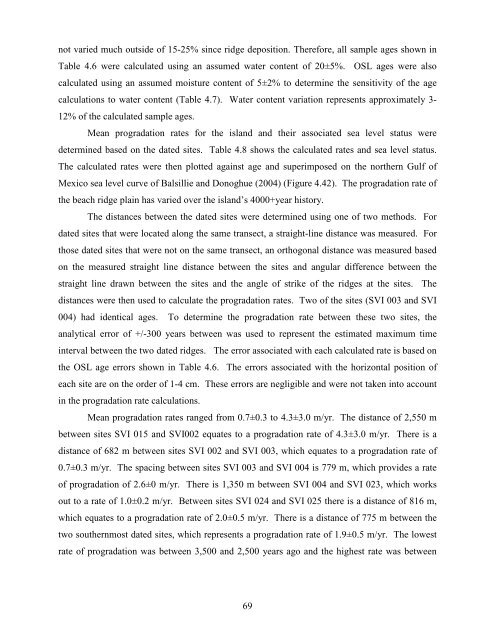the florida state university college of arts and sciences evolution of ...
the florida state university college of arts and sciences evolution of ...
the florida state university college of arts and sciences evolution of ...
You also want an ePaper? Increase the reach of your titles
YUMPU automatically turns print PDFs into web optimized ePapers that Google loves.
not varied much outside <strong>of</strong> 15-25% since ridge deposition. Therefore, all sample ages shown in<br />
Table 4.6 were calculated using an assumed water content <strong>of</strong> 20±5%. OSL ages were also<br />
calculated using an assumed moisture content <strong>of</strong> 5±2% to determine <strong>the</strong> sensitivity <strong>of</strong> <strong>the</strong> age<br />
calculations to water content (Table 4.7). Water content variation represents approximately 3-<br />
12% <strong>of</strong> <strong>the</strong> calculated sample ages.<br />
Mean progradation rates for <strong>the</strong> isl<strong>and</strong> <strong>and</strong> <strong>the</strong>ir associated sea level status were<br />
determined based on <strong>the</strong> dated sites. Table 4.8 shows <strong>the</strong> calculated rates <strong>and</strong> sea level status.<br />
The calculated rates were <strong>the</strong>n plotted against age <strong>and</strong> superimposed on <strong>the</strong> nor<strong>the</strong>rn Gulf <strong>of</strong><br />
Mexico sea level curve <strong>of</strong> Balsillie <strong>and</strong> Donoghue (2004) (Figure 4.42). The progradation rate <strong>of</strong><br />
<strong>the</strong> beach ridge plain has varied over <strong>the</strong> isl<strong>and</strong>’s 4000+year history.<br />
The distances between <strong>the</strong> dated sites were determined using one <strong>of</strong> two methods. For<br />
dated sites that were located along <strong>the</strong> same transect, a straight-line distance was measured. For<br />
those dated sites that were not on <strong>the</strong> same transect, an orthogonal distance was measured based<br />
on <strong>the</strong> measured straight line distance between <strong>the</strong> sites <strong>and</strong> angular difference between <strong>the</strong><br />
straight line drawn between <strong>the</strong> sites <strong>and</strong> <strong>the</strong> angle <strong>of</strong> strike <strong>of</strong> <strong>the</strong> ridges at <strong>the</strong> sites. The<br />
distances were <strong>the</strong>n used to calculate <strong>the</strong> progradation rates. Two <strong>of</strong> <strong>the</strong> sites (SVI 003 <strong>and</strong> SVI<br />
004) had identical ages. To determine <strong>the</strong> progradation rate between <strong>the</strong>se two sites, <strong>the</strong><br />
analytical error <strong>of</strong> +/-300 years between was used to represent <strong>the</strong> estimated maximum time<br />
interval between <strong>the</strong> two dated ridges. The error associated with each calculated rate is based on<br />
<strong>the</strong> OSL age errors shown in Table 4.6. The errors associated with <strong>the</strong> horizontal position <strong>of</strong><br />
each site are on <strong>the</strong> order <strong>of</strong> 1-4 cm. These errors are negligible <strong>and</strong> were not taken into account<br />
in <strong>the</strong> progradation rate calculations.<br />
Mean progradation rates ranged from 0.7±0.3 to 4.3±3.0 m/yr. The distance <strong>of</strong> 2,550 m<br />
between sites SVI 015 <strong>and</strong> SVI002 equates to a progradation rate <strong>of</strong> 4.3±3.0 m/yr. There is a<br />
distance <strong>of</strong> 682 m between sites SVI 002 <strong>and</strong> SVI 003, which equates to a progradation rate <strong>of</strong><br />
0.7±0.3 m/yr. The spacing between sites SVI 003 <strong>and</strong> SVI 004 is 779 m, which provides a rate<br />
<strong>of</strong> progradation <strong>of</strong> 2.6±0 m/yr. There is 1,350 m between SVI 004 <strong>and</strong> SVI 023, which works<br />
out to a rate <strong>of</strong> 1.0±0.2 m/yr. Between sites SVI 024 <strong>and</strong> SVI 025 <strong>the</strong>re is a distance <strong>of</strong> 816 m,<br />
which equates to a progradation rate <strong>of</strong> 2.0±0.5 m/yr. There is a distance <strong>of</strong> 775 m between <strong>the</strong><br />
two sou<strong>the</strong>rnmost dated sites, which represents a progradation rate <strong>of</strong> 1.9±0.5 m/yr. The lowest<br />
rate <strong>of</strong> progradation was between 3,500 <strong>and</strong> 2,500 years ago <strong>and</strong> <strong>the</strong> highest rate was between<br />
69

















